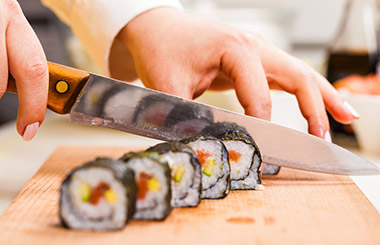Food Safety Precautions
Japanese-style foods are becoming increasingly popular with the most common dishes being sushi and sashimi. Sushi is traditionally made with vinegar rice, seaweed wraps, vegetables, raw seafood, and occasionally cooked seafood. Sashimi is a dish of raw seafood served on its own. Eating sushi and sashimi is risky, especially if precautions aren’t taken, because you’re consuming raw foods. Raw seafood may contain different parasites, viruses, and bacteria which make it very important to take steps to prevent foodborne illness. These precautions are to be used in a restaurant AND when attempting to prepare sushi at home.

In the past, most foodborne illness associated with sushi has been caused by Vibrio parahaemolyticus, Staphylococcus aureus, various types of Salmonella, Listeria monocytogenes, and parasites, such as Anasakinae and Diphyllobothrium.
Who Should Avoid Sushi?
People who have a weakened immune system should limit, or avoid eating sushi altogether. Young children, the elderly, pregnant women, and those who have an illness that weakens their immune system should not eat sushi because of the increased risk in consuming raw seafood.
Safe food handling measures when preparing and using rice:
- Bacteria, such as Bacillus cereus, can grow in rice dishes under ideal conditions. The rice you’re making needs to be kept refrigerated at 4°C (40°F) or acidified to be safe to eat.
- Cooked rice is to be kept hot at, or above, 60°C (140°F) because bacteria doesn’t grow well in foods at this temperature.
- Rice stored at room temperature must be acidified to prevent bacteria from growing and used the day it was prepared. Leftover rice must be discarded if it’s not used that day.
- Having a consistent recipe will help to keep the pH (meaning acidity level) of the rice the same for each batch prepared.
- The rice must have a pH of 4.6 or lower. A pH calibrator is an excellent way to ensure the rice is acidic enough to prevent bacteria from growing.
- If rice is not acidified or kept hot, it must be kept cold in the refrigerator.
Safe food handling measures for preparing and serving sushi and sashimi:
- Seafood used in making sushi should be labeled as sushi grade seafood. Fish that’s consumed raw in sushi must be frozen to -20°C (-4°F) for 7 days or -35°C (-31°F) for 15 hours. This process will destroy any parasite in the fish making it safer to consume but there’s still risk.
You should never assume that seafood from the grocery store is safe to use – always look for sushi grade labelled seafood. - It’s your responsibility as the food handler, whether at a restaurant or at home, to ensure safe food handling is being done.
- As a restaurant operator you should request and keep documentation showing the fish has been properly treated to ensure the parasites have been destroyed.
There are certain species of tuna that don’t need to be frozen prior to being eaten raw, such as:
- Albacore tuna
- Yellowfin tuna ahi
- Blackfin tuna
- Bluefin tuna
- Bigeye tuna
- Bluefin tuna, northern
When preparing sushi dishes, a large amount of food handling is involved from preparing the rice, vegetables, and seafood, to making the dish and preparing the rolls. It’s important to be aware of cross-contamination because of the handling of raw and cooked foods.
- Wash hands before handling food and after touching raw food.
- Never handle food if you’re feeling ill.
- Keep raw foods separate and away from ready-to-eat foods.
- Clean and sanitize surfaces and equipment after use.
- Foods which are potentially hazardous must be kept refrigerated when not in use.
- Never defrost frozen foods at room temperature. Foods should be thawed in the refrigerator or under cold, clean, running water.
- If the bamboo mat used to roll the sushi isn’t non-absorbent (waterproof), the mat should be lined with food grade plastic wrap that’s changed every 2 hours and after each contact with raw fish.
Prepared rolls should be refrigerated if not being served immediately. Rolls intended to sit at room temperature must not be out for more than 2 hours.
If food is displayed at room temperature there must be a system in place to monitor how long the food is out and when it should be disposed. Foods at room temperature for longer than 2 hours must be thrown out.
References:
- Alberta Health Services. (2016). Guidelines for preparing sushi products. Retrieved from: https://www.albertahealthservices.ca/assets/wf/eph/wf-eh-guidelines-for-sushi-prep.pdf
- BC Centre for Disease Control. (2010). Sushi safety. Retrieved from: http://www.bccdc.ca/resource-gallery/Documents/Educational%20Materials/EH/FPS/Fish/SushiSafety.pdf
- NSW Food Authority. (2007). Food safety guidelines for the preparation and display of sushi. Retrieved from: http://www.foodauthority.nsw.gov.au

